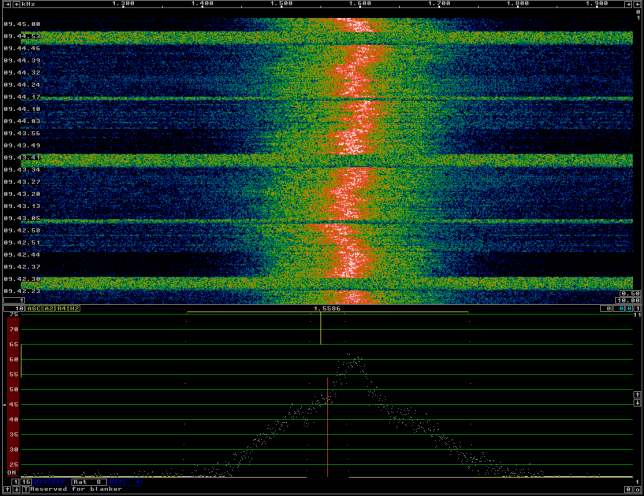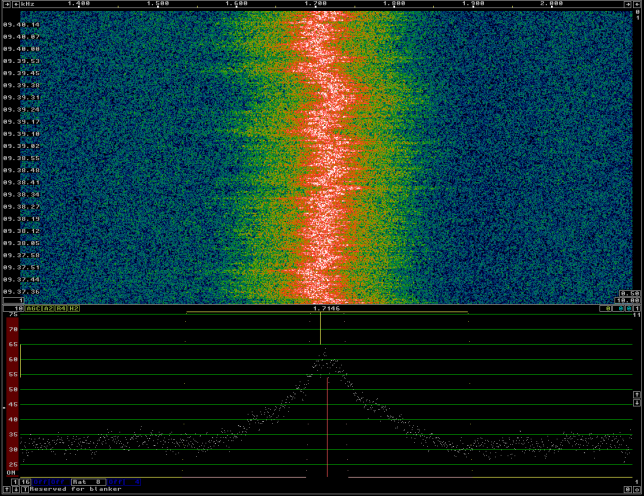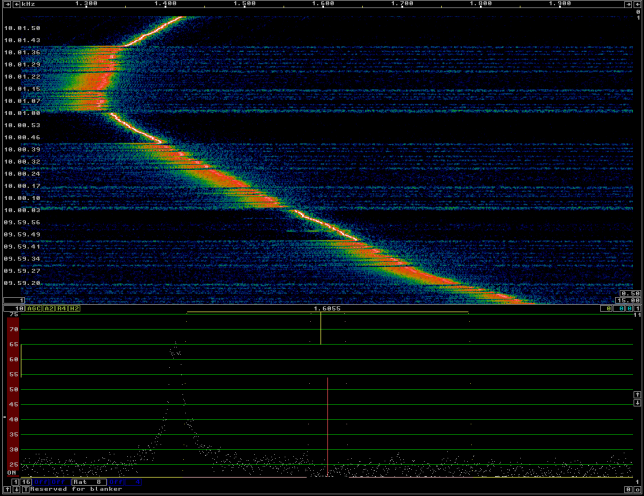I have being receiving several 10GHz on different WebSDRs with linrad to get a rough idea of the performance of the beacons and receivers, both in terms of frequency stability and phase noise. Here are the results.
First we look at the Paella Team SDR, located in IM98TJ, near Alicante. Luis EA5DOM reports that it is using a 27MHz PLL by DF9NP and a 10MHz OCXO. The antenna is an offset dish beaming to Ibiza to check for tropospheric propagation. The beacons ED5YAE and ED5YAF are received indirectly through reflections. They use PLLs to generate 10GHz, so their signals are not supposed to be very clean. There is also a Baofeng UV-3R used as a signal source.
ED5YAE is frequency locked to a GPSDO. We see that the frequency wobbles more or less 50Hz. Keep in mind that this is due to the combined effects of the GPSDO at ED5YAE and the OCXO at the WebSDR. The signal is spread about 30Hz. I don’t know if this is due to the transmitter, the receiver, or propagation. We can also note a second “hump” of phase noise, about 200Hz wide. It is green on the waterfall.

ED5YAF is near the receiver, so the signal is much stronger. Otherwise, phase noise and frequency stability are similar to ED5YAE. Since the signal is strong, phase noise is quite noticeable.

The Baofeng also displays similar characteristics. This is curious. People report that the Baofeng is surprisingly quite stable in frequency. I haven’t seen any measurements of its phase noise. I’ll have to make some measurements on my own Baofeng.

Luis EA5DOM also reports that frequently the beacons can be received through reflections on ships. This causes a Doppler shift of 200 to 300Hz. I haven’t seen these reflections, but it would be very interesting to study them.
Next, we look at the SUWS WebSDR. The beacon GB3SEE can be received very strong in this SDR. GB3SEE is frequency locked, but the receiver is not (I think it uses an unmodified LNBF). Thus, frequency stability is not very good, but surprising for the unmodified LNBF. Phase noise is very good. Just look at the periods when the beacon transmits an unmodulated carrier.

Now we look at a WebSDR in Dresden, locator JO61VA51. This SDR receives the beacon DM0TUD/B, but the frequency stability is very poor. Phase noise is very good.

Finally, we look at a WebSDR in Belgium. The receiver is GPS locked. An unidentified beacon can be received there. The frequency stability is extremely good. The phase noise is also good, but if one looks carefully at the periods of unmodulated carrier, one can see a faint “green hump” about 10Hz wide. This will hardly cause any problem.

so interesting, found this as i was tracking the signals of unethical medical implants sending and receiving frequencies to satellites